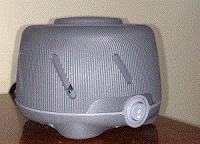Roku Streaming Stick 4K (2021)
 |
We’ll get this out of the way, right up front: the reason I bought a new version of the Roku Streaming Stick 4k (2021 version) is that my old one would no longer support streaming Amazon Video. Don’t ask me why… We’ve had a Roku in the mix since about 2014, first a Roku 2 (replaced last year for the same [suspicious] reason) and later a earlier-generation Roku Streaming Stick (3500R). The two go along with a trio of Google Chromecasts that cover three of our four televisions; one of which travels with us when we rent from VRBO or Air B&B. I bought this model from Amazon, where the price has increased by something like 56% since I placed the order. Lucky me… except that I had to send the first one back, and the replacement got lost in transit. Try talking someone at Amazon “support” into sending you a new one instead of issuing a refund so that you can buy another at the new, “improved” price. Sheesh! |
Whatever the case, I got the replacement and lo and behold, it had exactly the same “problem” as the original. It took some sleuthing, but I finally found out what was up. More on that later. The stick plugs directly into an HDMI port on the Television and is powered by a cord with a micro-USB on one end and a full-sized USB on the other. You can either plug it into a USB port on the television (not all TVs will power the unit) or into the supplied wall adapter. The cord has a fat plastic section that Roku (somewhere) says is a WiFi booster. I didn’t need it, but it’s probably nice to have.
The stick itself is about 20% longer than the model it replaced (84mm vs. 69mm), making it too large to fit into one of the HDMI ports. Lots of people complain about that, enough that Roku will send you a free flexible extender if you can find the order form. They are, of course, backordered… for three months.
Setup is typical Roku; plug it in and follow the on-screen instructions; you’ll have to enter a code on the Roku website as well as an email address and password. Just like every smartphone, Roku then automatically installs about seventy channels of bloatware, including such clinkers as the golf channel. OK, maybe some people like to watch golf…
On the GOOD side, the streaming stick is wicked fast compared to my old version, which was about five years old. The remote (included, as are 2 AAA batteries) has been upgraded to include volume controls and a mute button on the right-hand side and a voice control button where the OK button used to be. There’s also a power button that can be used to control the television. That’s in addition to the usual array of right-left-up-down-back-home-pause. Four pre-programmed buttons take you to Netflix, Hulu, Disney+ (pbbbbt) and Apple-tv (double-pbbbbbbt). Still can’t program them to your choice of streaming services.
On the BAD side, there’s damned near no documentation for this thing, so it was only by accident that I learned that the unit has a power-save mode that is, for unknown reasons, set to ON by default. Since it’s not documented anywhere, you won’t know that this is the reason the unit has to be reset every time you want to use it. Can you say, “Pain in the ass?”
|
So here are my two tips for living with this new version of the Roku Streaming Stick. First, find the power-save function (it’s in system settings) and turn it off. Otherwise you’ll be cursing Roku for the duration. Second, if you power the stick with the TV’s USB port, DO NOT set the power button on the Roku remote to control the television power. If you do, the television won’t come on until the Roku boots up ten seconds, maybe) and then you hit the power button. Again, PitA. Once I figured out those two caveats, I’m perfectly happy with my Roku Streaming Stick 4K, and will most likely stay that way until the company makes a deal with Netflix or Hulu to stop supporting their streaming, thereby forcing me to buy a couple more Rokus. Oh, well, at least they’re faster than the old ones… |
Summary
PLUS: wicked fast, good streaming experience, upgraded remote function, interfaces with Alexa, Siri, or Hey! Google
MINUS: poor documentation of "hidden" features, bloatware channels
WHAT THEY'RE SAYING: Cut the cord and get a Roku.
copyright © 2022-2023 scmrak










